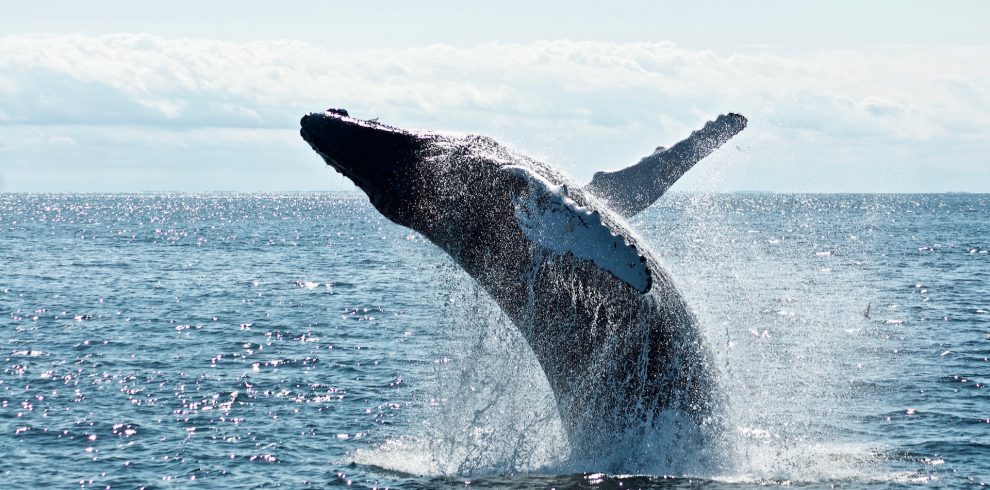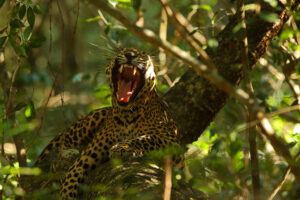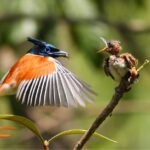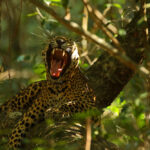See playful and mischievous dolphins dancing above the waters; the Blue Whale, the largest aquatic mammal on earth and humpback whales sail effortlessly past you as you venture out on a dolphin and whale watching in Sri Lanka, a place where the BBC documentary titled “Ocean Giants” featuring the amazing world of Whales and Dolphins was filmed around the island and according to them 30 Blue Whales were sighted in a single day.
Go on whale watching tours of Sri Lanka taking you to the most crucial locations for this well loved leisure activity which are Dondra Point which can be accessed from Galle, Hikkaduwa and Mirissa, east coast of Trincomalee and the seas off Kalpitiya Peninsula.
Mirissa
Mirissa thrives on the whale watching industry and it is what made Mirissa the place it has become today. The whale watching Sri Lanka season starts in December to April and many dolphins can be seen especially the spinner dolphins. There are boat trips to go whale watching in Mirissa during this season which gives great chances of spotting Blue Whales just off Dondra Point since it is along the migration path from Africa to Australia.
Please do contact Aviyana Ceylon tour consultants for further enquiries in the search for your ideal sea mammal excursion filled holiday in Sri Lanka.
Types of Cetaceans
Blue Whale
Blue whales are the largest animals ever known to have lived on Earth. These magnificent marine mammals rule the oceans growing to lengths of up to 100 ft. long and weighing as much as 150 tons or more. Blue whale feed at a depth of less than 330 feet and consume 4 Tons of krill a day, but it can dive up to 1640 feet and it will last for 10- 20 minutes.In addition to the blue whale’s massive size it is also one of the loudest animals in existence. In fact, a blue whale’s calls can be heard several miles away and far below the ocean’s surface.
Even though they are massive animals their body is relatively slim and streamlined for speed and long distance travel allowing them to swim up to 25 miles per hour or more when the feel threatened. Blue whale’s average life span is 80-90 years. Their tongues alone can weigh as much as an elephant. Their hearts, as much as an automobile.
Listen to the Blue Whale Sound
Bryde Whale
Bryde’s whale is a small to medium-sized whale which can be found swimming throughout the tropical/subtropical climates of the world. bryde’s whale can reach lengths of up to 55 ft and weigh up to 30 tons when it is fully matured, depending on where they live these whales may only grow to be 40 – 50 ft long. On average male whales tend to be slightly smaller than their female counterparts. This whale gets its name from Johan Bryde, an entrepreneur and businessman from the Norwegians who was responsible for setting up whaling ports designed to capture whales and sell their oil, blubber and other parts for money.
Killer Whale
While the killer whale carries the name “whale” as part of its description this marine mammal is actually considered a dolphin. In addition to being known as the killer whale these marine mammals may also be referred to as the Blackfish or the Orca. Killer whales are one of the most well-recognized animals in the world and are easily spotted by their large size and distinct black and white color pattern. In fact the killer whale is the largest animal in the dolphin family and is one of the only known cetaceans to attack sharks, whales and other large marine animals.
Sperm Whale
Sperm whales are easily recognized by their massive heads and prominent rounded foreheads. They have the largest brain of any creature known to have lived on Earth. Their heads also hold large quantities of a substance called spermaceti. Whalers once believed that the oily fluid was sperm, but scientists still do not understand the function of spermaceti. One common theory is that the fluid—which hardens to wax when cold—helps the whale alter its buoyancy so it can dive deep and rise again. Sperm whales are known to dive as deep as 3,280 feet (1,000 meters) in search of squid to eat. These giant mammals must hold their breath for up to 90 minutes on such dives.
Bottlenose dolphin
The bottlenose dolphin belongs to the group commonly known as Cetacea which also includes whales , they are very social creatures and will often approach humans out of curiosity. Their high level of intelligence, ability to learn and perform complex tasks combined with an outgoing nature have made them very popular among people. Their typical diet includes consuming prey such as fish, eel, shrimp and other crustaceans and squid. The bottlenose dolphin belongs to the group commonly known as Cetacea which also includes whales , they are very social creatures and will often approach humans out of curiosity. Their high level of intelligence, ability to learn and perform complex tasks combined with an outgoing nature have made them very popular among people. Their typical diet includes consuming prey such as fish, eel, shrimp and other crustaceans and squid. The average length of these dolphins varies between 6 1/2 ft. and 13 1/2 ft. with males typically being larger than their female counter parts
Spinner dolphin
Spinner dolphins are probably the most frequently encountered cetacean in nearshore waters of the Pacific Islands Region. Spinner dolphins received their common name because they are often seen leaping and spinning out of the water. The species’ name, longirostris, is Latin for “long beak,” referring to their slender shaped beak or rostrum. Regarded as one of the most acrobatic of dolphins, spinner dolphins are well known for their habit of leaping from the water and spinning up to seven times in the air before falling back into the water. Experts believe that spinner dolphins use these behaviours primarily for acoustic signalling or communication, but the activity can also be a way to remove ectoparasites, such as remoras.
Trincomalee
Whale watching in Trincomalee is another dolphin and whale watching destination along the east coast of Sri Lanka. Its shallow teal blue waters have dolphins and whales popping up during the months of May to October. The calm seas give favourable conditions to ride out to the deep sea to see the marine giants of Blue Whales and sperm whales. These can be viewed around 6-8 miles east off the coast of Trincomalee which is approximately a 30 minutes boat ride. Seeing blue whales in their natural habitat is a rare and unique opportunity. Dolphins, the main being the Spinner dolphins are seen playing, dancing and showing off their acrobatic skills. Other dolphins that can be seen are Bottlenose Dolphins and Fraser’s Dolphins. Most sightings of the dolphin occur between March/April and August/September.

The blue whale does make an appearance in this region, though not as commonly as in Mirissa, but the world’s…
Kalpitiya
Kalpitiya is best known as the ultimate destination for offshore spinner dolphin and whale watching on the island, as the coastal waters bordering the peninsula is often the haunt of marvellous dolphin pods and whales. These large pods of dolphins include the spinner dolphins. One need not venture too far out into the ocean for these sightings for the continental shelf of Kalpitiya lies within close range of the shoreline. Boat excursions for dolphin and whale watching are conducted by trained and certified guides and generally begin at Alankuda beach. The season for Dolphin watching is from November to March/April; this is the monsoon season and the sea is likely to be less rough, thereby making it easier to sight dolphins. The calmness also contributes to a higher visibility amid the waters that allows one to glimpse dolphins from afar.
Dolphin Watching
The season for Dolphin watching is from November to March/April; this is the monsoon season and the sea is likely to be less rough, thereby making it easier to sight dolphins. The calmness also contributes to a higher visibility amid the waters that allows one to glimpse dolphins from afar. This winter season is also ideal seeing as dolphins migrate here from cold waters. One may witness superpods with up to 1000 dolphins during this period.
Dolphin watching tours generally take place during dawn and last for 2-3 hours. Pods containing hundreds of dolphins can usually be sighted at the famous Bar Reef situated one-hour boat ride away. Most common species roaming the Kalpitiya waters are the long snouted Spinner dolphin seeing as offshore tropical waters usually serves as their habitat. Bottlenose, Risso and Indo-Pacific Humpbacks dolphins can also be spotted in Kalpitiya. These charming and playful acrobats are indisputably a delight to behold.
Whale watching
The season for whale watching is between December and April, with months March and April being the most ideal. The deep waters surrounding Kalpitiya are roamed by five types of whales.
Majestic Sperm whales, also known as cachalot, can be found nearby during this period. You may witness pods of whales of up to 7, 15, 20 or even 50 whales. Currently on the endangered list, these remarkable mammals are the largest toothed predators on Earth and the largest of the toothed whales. Sperm whales also have the largest brain in existence, weighing four times more than that of a human. Although considered a cosmopolitan species, wandering both tropical and cold waters, many years of whaling has rendered them locally extinct in regions such as Southern Australia. The presence of Sperm whales is sometimes accompanied with sightings of pelagic seabirds.
Sporadic but spectacular sightings of the magnificent Blue Whale, largest species known to have ever existed on Earth, can also be experienced in Kalpitiya waters. Other species of whale such as Minke, Melon-headed and Dwarf Sperm can also be spotted here.
Kalpitiya is one of the best locations for dolphin watching in Sri Lanka. Kalpitiya gives you an opportunity to watch hundreds of dolphins swimming alongside and diving under your boat, riding waves, jumping, spinning, twirling and leaping out of the water in a magical display, is a magnificent experience you will never forget in your lifetime. Tour consultants at Aviyana Ceylon Tours can assist you to organize boat excursions to experience whale and dolphin watching.






